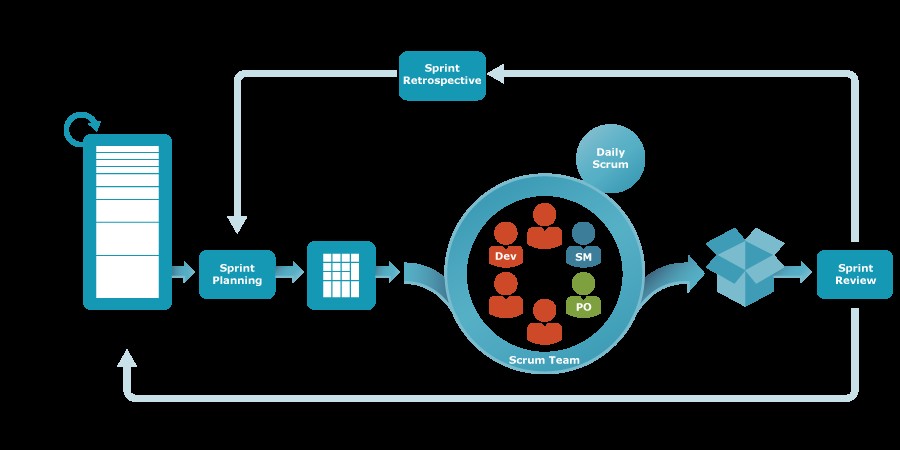Are you new to the world of agile methodologies and project management? You might have heard the term “Scrum” being thrown around. If you’re just starting out, think of Scrum as a straightforward and effective way for teams to collaborate and accomplish tasks by working in small, manageable chunks. It’s all about continuous improvement, learning from experience, and adapting as you go. Scrum is an agile framework designed to help teams deliver value incrementally and collaboratively. It provides just the right amount of structure to integrate into any team’s workflow, incorporating practices that can be tailored to meet specific needs and optimize performance. You might be wondering, “This sounds promising! But how do I actually begin with Scrum?”
 Scrum Framework
Scrum Framework
To get started, it’s essential to understand the Scrum framework. This framework is thoroughly described in the Scrum Guide, initially introduced in 1995 as an enhanced approach to team collaboration focused on solving complex problems. The Scrum framework is elegantly simple. It revolves around a Scrum Team, which includes three specific roles: the Product Owner, the Scrum Master, and Developers, each with clearly defined accountabilities. This Scrum Team participates in five key events and works with three artifacts. Ken Schwaber and Jeff Sutherland, the co-creators of Scrum, authored and continually update The Scrum Guide. This guide serves as the definitive source for understanding Scrum, clearly outlining Scrum accountabilities, events, artifacts, and the principles that link them together.
The Origin of the Name “Scrum”
People often ask, “Is Scrum an acronym?” The answer is no. The term “Scrum” is inspired by rugby. In rugby, a scrum is a tight formation of players working together to restart play after a minor infringement. Similarly, in the Scrum framework, the team comes together—much like in a rugby scrum—to collaborate and drive the product forward. It’s about teamwork, pushing towards a common goal, and moving the “product ball” down the field.
The Empirical Nature of Scrum: Pillars and Values
Scrum operates as an empirical process. This means that decisions in Scrum are made based on observation, experience, and experimentation rather than detailed upfront planning. Scrum is built upon three pillars: transparency, inspection, and adaptation. These pillars fundamentally support iterative work. Empiricism in Scrum encourages working through a series of small experiments, learning from each, and then adapting both the process and the product as needed. This iterative approach allows for flexibility and responsiveness to change, which is crucial in complex projects.
A vital characteristic that underpins all aspects of a Scrum Team is Trust. Without trust, tension and inefficiencies can significantly hinder progress. Furthermore, the Scrum Values are essential for guiding team behavior and fostering trust. These values are Commitment, Courage, Focus, Openness, and Respect. These values are not just aspirational; they are practical guides for how Scrum Team members should interact and work together, especially in environments where experimentation and learning are central to making progress.
Scrum in a Nutshell
In essence, Scrum thrives in an environment characterized by:
- Short Cycles (Sprints): Work is delivered in valuable increments within short cycles known as Sprints, typically lasting one month or less. Continuous feedback loops are built into each Sprint, allowing for regular inspection and adaptation of both the process and the deliverables.
- Accountable Scrum Team: Each Scrum Team consists of a Scrum Master, a Product Owner, and Developers. These roles are collectively accountable for transforming a selected set of work into a valuable Increment by the end of each Sprint.
- Stakeholder Collaboration: At the end of each Sprint, the Scrum Team, along with stakeholders (which may include organizational members, business partners, users, or customers), reviews the Sprint’s outcomes. This review process is crucial for making necessary adjustments for the next Sprint, ensuring alignment with evolving needs and goals.
Professional Scrum: Beyond the Basics
While grasping the fundamentals of the Scrum framework is crucial, truly effective Scrum—known as Professional Scrum—goes beyond simply following the mechanics. Teams can sometimes fall into the trap of merely going through the motions without fully embracing the spirit of Scrum. Professional Scrum demands a shift in mindset—in ways of working and thinking—and necessitates a supportive environment built on trust. It also requires a deep commitment to the Scrum Values in all aspects of work. This holistic approach is what defines Professional Scrum.
Continue Your Scrum Learning Journey
Numerous resources are available to deepen your understanding of Scrum, including books, presentations, and videos. However, the best place to start is always The Scrum Guide, which is the official definition of Scrum.
To further your learning, we recommend exploring insights from experienced Professional Scrum Trainers (PSTs) and Scrum.org staff on the Scrum.org Blog. You can also find a wealth of articles, white papers, videos, webinars, and other materials in the Resources section of our website. For those with questions or looking to learn from the queries of others, the Scrum Forum provides a valuable platform to connect with and learn from the broader Scrum community.
Video
An Introductory Video Series to Scrum
In this comprehensive 18-part series of short Scrum Tapas videos, Professional Scrum Trainer Ryan Brook offers a detailed walkthrough of the Scrum Framework. He breaks down each component, providing clear explanations and practical insights into how Scrum is effectively applied.
4.9 from 48 ratingsWeb Page
Applying Professional Scrum™ Training
Applying Professional Scrum™ (APS) is an immersive, hands-on, and activity-based course designed to let students experience firsthand how Professional Scrum and the Scrum framework enhance their ability to deliver value compared to traditional project management methodologies.
Web Page
Professional Scrum Master™ Training
Professional Scrum Master™ (PSM) is an engaging, interactive, and activity-driven course tailored to provide students with a robust understanding of Professional Scrum and the critical accountabilities of the Scrum Master role. Through a blend of in-depth discussions and practical exercises, participants will cultivate a profound grasp of the foundational principles…
